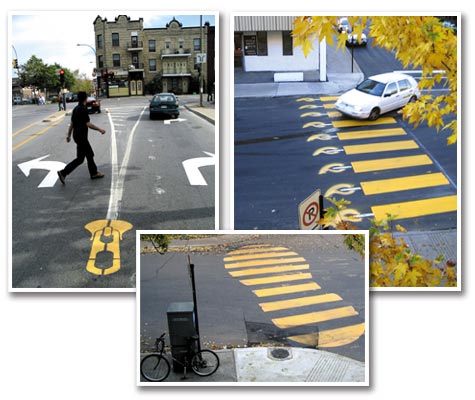|
|
The New Beautiful City The graffiti of Roadsworth has Montreal's politicians and police contemplating the differences between art and vandalism by Laura Boudreau : : : : : : : The grey area between graffiti and vandalism is more than theoretical for Roadsworth: his controversial street images have turned pavement into politics in the city of Montreal and rekindled debate about the nature of public art. The pieces were "very simple, open-ended, ambiguous,” says Gibson. “They were also somewhat integrated with the environment — the street, the road markings — giving them an almost subliminal quality.” Gibson adds, “I think my intention was to create a language that would function as a form of satire, accentuating the absurdity inherent to certain aspects of urban living, urban space, [and] public policy.” But evidently something got lost in translation: Montreal police arrested Gibson on November 29 last year and charged him with 51 counts of mischief, the charges carrying maximum penalties ranging from $200 to $5,000. Gibson defends his works, claiming that they create free dialogue within the city’s commercial monologue. An economic, anti-ecological imperative holds the city hostage, Gibson says, and this deference to industry is symptomatic of the hypocritical way laws are applied in the city setting. As Gibson notes, “We aggressively pursue graffiti writers for scrawling their names on a wall across from a massive backlit billboard advertising Big Macs.” Despite the claims of police that the Roadsworth images are a threat to public safety, Gibson argues that what they actually threaten is the corporate monopoly on public space. Many Montrealers agree. Chris Hand, Director of Zeke’s Gallery on the Plateau, says that “at the street level — and elsewhere — there is a tremendous amount of support for Peter. I have yet to hear anyone say that they didn’t like what he did, and the only complaints are to vague ideas of public security. After I show them pictures of what [artist] Maclean did [using red tape to change “ARRET” signs to read “A R T”], it causes them to realize that, in comparison, Peter’s work was very benign.” Gibson’s trial begins in January 2006, but his impact on Montreal will likely still be contested long after the courts decide his legal fate. Public space is full of competing and contradictory messages, but where is the line between public acts of self-expression and selfish acts of public vandalism? Roadsworth’s case highlights this debate surrounding art in public space. Pop culture expert Dr. Tim Blackmore of the University of Western Ontario sees “L’Affaire Roadsworth” as a missed opportunity for discussion about public art. “I’m sympathetic to Roadsworth’s politics and like his art, but that’s not the issue. I get the sense that a lot of what Roadsworth is doing is basically stickin’ it to The Man. I’m little convinced that road art will do this. It will cause The Man to allocate more money for repainting. “I think it’s a serious mistake for Montreal to drag Roadsworth into court,” Blackmore continues. “If I were in the position of advising the city, I would suggest that they meet with a collective of the graffiti artists and begin discussing public art seriously, allotting space for freestyle of all kinds.” Gibson agrees that access is key: “If I were a city councillor, I think I would designate a lot of public space as free space — space where one could express anything. “I love life in the city,” Gibson says. “I love the possibility for cultural and economic exchange.” It is, however, the collision between art and commerce in the public sphere that both inspires and infuriates Gibson, fuelling his unconventional form of protest: “Painting images on the street is actually a very innocuous gesture in the face of the problems that exist. We are living in serious denial if we feel that business as usual is going to ensure our continued survival and well-being.” : : : : : : : |
|
|
spacing.ca || contact || subscribe || stores || spacing wire || spacing photos (c) 2006 Spacing Publications
|

